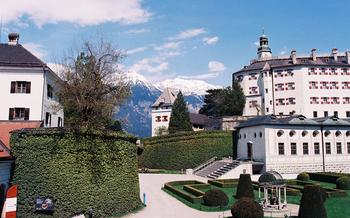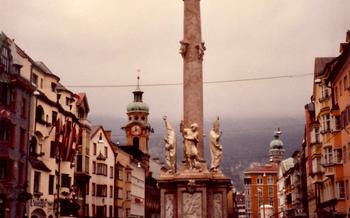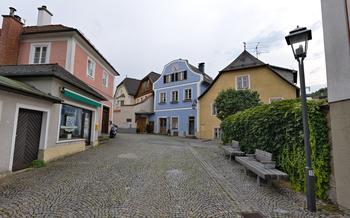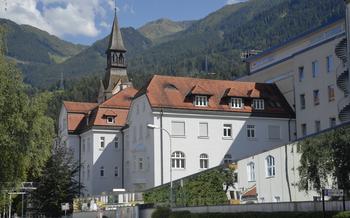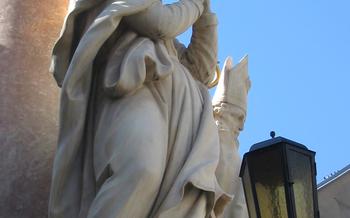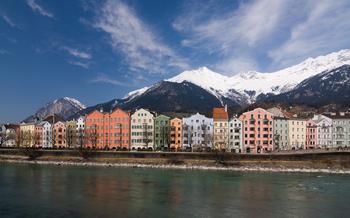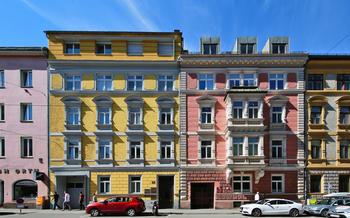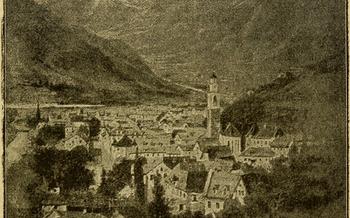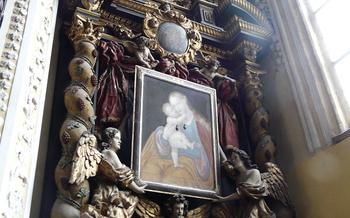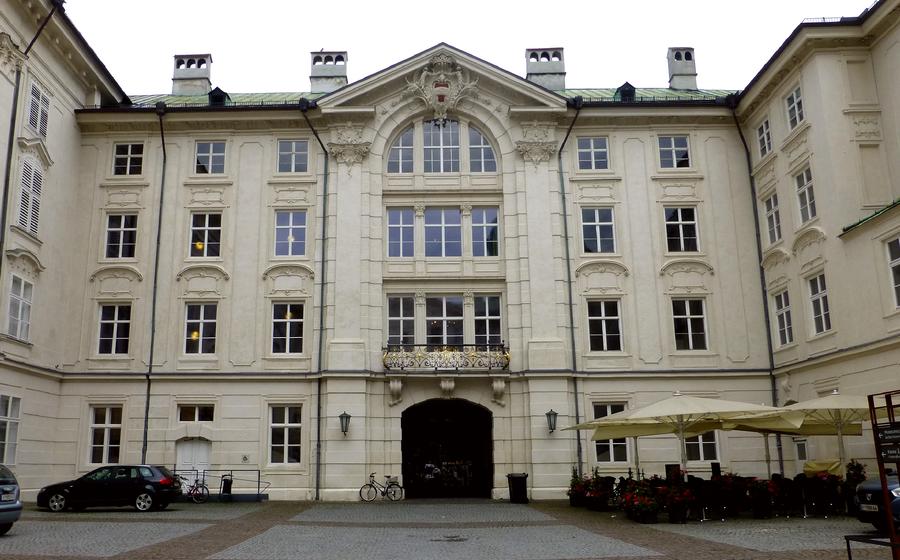
Kaiserliche Hofburg Innsbruck
- Imperial Hofburg Palace in Innsbruck: A Historical Jewel
- Hofburg's Majestic Facade and Courtyard
- Exploring the Imperial Apartments
- Hofburg's Captivating Giant Hall
- Imperial Silver Chamber and Its Treasures
- Walking Through the Imperial Gardens
- Hofburg Music Museum: A Journey of Sound
- Hofburg Chapel and Its Sacred Art
- Tyrolean State Museum in the Hofburg
- Hofburg's Imperial Library: A Treasure Trove of Knowledge
- The Golden Roof and Its Fascinating History
- The Hofkirche: A Sacred Masterpiece
- Best Time to Visit the Hofburg
- Insider Tip: Hidden Gems of the Hofburg
Imperial Hofburg Palace in Innsbruck: A Historical Jewel
In the heart of Innsbruck, nestled amidst the stunning Tyrolean Alps, lies the majestic Imperial Hofburg Palace, a testament to the rich history and grandeur of the Habsburg dynasty. Built in the 15th century, this magnificent palace served as the official residence of the Habsburg emperors and played a pivotal role in the political and cultural landscape of Europe for centuries.
The Hofburg's architectural style is a blend of Gothic, Renaissance, and Baroque influences, reflecting the evolving tastes and artistic trends of its time. Its impressive facade, adorned with intricate carvings, statues, and ornamental details, hints at the opulent interiors that await visitors. The palace is a symbol of the Habsburg dynasty's power and prestige, standing as a testament to their reign over the vast Austro-Hungarian Empire.
Hofburg's Majestic Facade and Courtyard
The Imperial Hofburg Palace in Innsbruck captures hearts with its stunning facade, a testament to the grandeur of the Habsburg dynasty. Intricate details adorn the exterior, showcasing a harmonious blend of Baroque and Renaissance architectural styles. The imposing facade, with its elegant symmetry and intricate carvings, beckons visitors to step into a world of imperial splendor.
As you enter the palace grounds, the grandeur of the courtyard unfolds before you. Enclosed by majestic arcades and adorned with intricate sculptures, the courtyard exudes an aura of opulence. The harmonious blend of architectural elements creates a sense of awe and transports visitors back in time to the era of imperial power.
The symbolic sculptures and carvings that adorn the facade and courtyard hold profound meanings, reflecting the Habsburgs' imperial aspirations and their deep-rooted connection to the region. These intricate details add depth and character to the palace, making it a true masterpiece of architectural artistry.
Exploring the Imperial Apartments
Step inside the opulent imperial apartments of the Hofburg Palace and immerse yourself in the grandeur of the Habsburg dynasty. These private chambers, once home to emperors and empresses, offer a glimpse into the lavish lifestyle and rich history of the royal family.
Wander through the elegant halls and admire the intricate tapestries, shimmering chandeliers, and opulent furnishings that adorn the rooms. Each chamber tells a story of the Habsburgs' reign, from their personal lives to their official duties.
In the Emperor's Bedroom, you can almost sense the presence of Franz Joseph I, the last emperor of Austria, as you stand where he once slept. The room is adorned with personal belongings, including his uniforms, medals, and family portraits, offering a glimpse into his private life.
The Empress's Chambers, on the other hand, exude a sense of femininity and grace. Adorned with delicate fabrics, exquisite jewelry, and an impressive collection of gowns, these rooms showcase the elegance and refinement of the Habsburg women.
As you explore the imperial apartments, you'll come across stunning works of art, including paintings by renowned masters and sculptures that depict the Habsburg lineage. These treasures not only add to the opulent ambiance but also serve as reminders of the family's patronage of the arts.
Don't miss the opportunity to step into the Habsburgs' private study, where they conducted official business and made decisions that shaped the course of history. The room is filled with books, maps, and globes, reflecting the rulers' thirst for knowledge and their commitment to their responsibilities.
The imperial apartments of the Hofburg Palace offer a unique opportunity to journey back in time and experience the grandeur of the Habsburg dynasty. As you wander through these opulent chambers, you'll gain a deeper understanding of the lives and legacies of the rulers who once called this magnificent palace home.
Hofburg's Captivating Giant Hall
The Giant Hall (Riesensaal), located within the Imperial Hofburg Palace in Innsbruck, is a testament to the grandeur and extravagance of the Habsburg dynasty. Built in the 18th century, this awe-inspiring hall was designed to serve as a ceremonial and festive space, hosting lavish banquets, balls, and receptions that showcased the opulence and power of the imperial court.
With its impressive dimensions and soaring height, the Giant Hall exudes a sense of majesty and grandeur. The hall's Baroque-style architecture is characterized by intricate stucco work, opulent chandeliers, and a ceiling adorned with stunning frescoes that depict scenes from the life of Emperor Leopold I. The walls are lined with large windows that flood the hall with natural light, creating a luminous ambiance that enhances its grandeur.
Throughout its history, the Giant Hall has witnessed countless significant events and celebrations. It served as the venue for the wedding of Empress Maria Theresa to Francis I of Lorraine in 1736, a union that marked the beginning of the Habsburg-Lorraine dynasty. The hall has also hosted sumptuous banquets, balls, and concerts attended by European royalty, diplomats, and dignitaries, showcasing the Habsburgs' refined taste for entertainment and their ability to impress their guests with lavish displays of wealth and power.
One of the most intriguing aspects of the Giant Hall is its connection to the imperial family. It is said that Emperor Franz Joseph I, who reigned for over 68 years, had a particular fondness for the hall and often used it as his private ballroom. It is easy to imagine the emperor and his court waltzing gracefully across the polished marble floor, surrounded by the hall's opulent decor and the soft glow of candlelight.
Today, the Giant Hall is open to the public and serves as a venue for concerts, exhibitions, and special events. Visitors can admire its architectural splendor, marvel at its historical significance, and immerse themselves in the atmosphere of imperial grandeur that lingers within its walls.
Imperial Silver Chamber and Its Treasures
For centuries, the Habsburgs amassed an impressive collection of silverware and tableware, showcasing their wealth and status. The Imperial Silver Chamber, located within the Hofburg, houses this extraordinary collection, allowing visitors to marvel at the exquisite craftsmanship and artistry of these precious objects.
The chamber is adorned with intricate carvings, polished mirrors, and gleaming chandeliers, creating an opulent setting for the display of silver masterpieces. Among the highlights of the collection are elaborate dinner services, ornate cutlery, and ceremonial pieces that were once used by the Habsburg emperors and their guests during lavish banquets and celebrations.
Each piece in the collection holds historical significance, reflecting the Habsburgs' taste, opulence, and diplomatic relations. Visitors can learn about the origins of the silver, the techniques used in its creation, and the stories behind its use in royal dining customs.
One of the most captivating pieces is the "Goldenes Service," a magnificent dinner service made of pure gold, crafted by renowned goldsmiths to impress visiting dignitaries. Another highlight is the "Große Tafelaufsatz," a stunning centerpiece that features intricate figurines and allegorical representations of the Habsburg dynasty.
The Imperial Silver Chamber offers a glimpse into the extravagant lifestyle of the Habsburgs, allowing visitors to appreciate the artistry and craftsmanship that went into creating these precious objects. It is a testament to the opulence and splendor that characterized the imperial court of Austria.
Walking Through the Imperial Gardens
Strolling through the picturesque Imperial Gardens, visitors are transported to an oasis of tranquility amidst the grandeur of the Hofburg Palace. Designed in the Baroque style, the gardens feature intricate landscaping, manicured lawns, and a rich variety of plant life. The formal gardens, with their symmetrical layout and colorful flower beds, offer a striking contrast to the towering peaks of the surrounding mountains.
As you wander through the gardens, take time to admire the statues and fountains that adorn the grounds. These elegant works of art depict mythological figures, historical scenes, and allegorical representations of the Habsburg dynasty. The gardens also offer stunning views of the surrounding city and mountains, making them a popular spot for locals and tourists alike to relax and enjoy the fresh air.
The Imperial Gardens were once a private retreat for the Habsburg emperors and their families. Today, they are open to the public and offer a glimpse into the lavish lifestyle of the imperial court. Visitors can stroll along the paths, admire the beautiful flowers, and imagine what it was like to be a Habsburg emperor, enjoying the serenity of these private gardens.
Hofburg Music Museum: A Journey of Sound
The Hofburg Music Museum invites you on a captivating journey through the world of music and its connection to the Habsburg court. Immerse yourself in the rich musical heritage of Austria as you explore the museum's exceptional exhibits and collections.
The museum showcases a vast array of historical instruments, from intricate stringed instruments to grand pianos that once graced the imperial court. Each instrument has a story to tell, highlighting the evolution of music and the role it played in Habsburg society.
Interactive exhibits provide an immersive experience, allowing you to engage with the exhibits and discover the sounds of the past. Listen to the delicate melodies of early music, the grandeur of classical compositions, and the infectious rhythms of Tyrolean folk music.
The museum's collection extends beyond instruments, featuring exhibits on the history of opera, court balls, and the influence of music on the Habsburg dynasty. Learn about the renowned composers who performed at the imperial court and the role music played in shaping the cultural landscape of Vienna and beyond.
As you wander through the museum, you'll uncover the deep connection between music and the Habsburgs. Music was an integral part of court life, providing entertainment, enhancing ceremonies, and reflecting the dynasty's cultural and political power.
Hofburg Chapel and Its Sacred Art
The Hofburg Chapel, nestled within the Imperial Hofburg Palace in Innsbruck, stands as a testament to the Habsburgs' deep-rooted Catholic faith and their commitment to religious expression. This sacred space exudes an atmosphere of awe and reverence, inviting visitors to immerse themselves in its rich history and artistic splendor.
The chapel's interior is a symphony of Baroque opulence, featuring intricate stucco work, gleaming gold leaf, and vibrant frescoes that depict scenes from the Bible and the lives of saints. The high altar, a masterpiece of Baroque craftsmanship, is adorned with intricate carvings and statues that tell the story of the Crucifixion and Resurrection.
A highlight of the chapel is the magnificent stained glass windows, which flood the interior with a kaleidoscope of colors and intricate designs. These windows, crafted by skilled artisans, depict biblical scenes and the coats of arms of the Habsburg dynasty, adding to the chapel's grandeur and symbolism.
The Hofburg Chapel has served as a sacred venue for significant religious ceremonies throughout history, including royal weddings, christenings, and funerals. It was here that Emperor Maximilian I, the Holy Roman Emperor, married Bianca Maria Sforza in 1494, in a lavish ceremony that showcased the Habsburgs' power and influence.
In addition to its religious significance, the Hofburg Chapel is also a treasure trove of sacred art. Visitors can admire exquisite paintings by renowned Tyrolean artists, depicting scenes from the life of Christ and the Virgin Mary. The chapel also houses a collection of precious relics, including a fragment of the True Cross, which is believed to have been brought to Innsbruck by Emperor Maximilian I.
Whether you are a devout pilgrim or simply an art enthusiast, the Hofburg Chapel offers a profound and awe-inspiring experience. This sacred space invites you to marvel at its architectural beauty, immerse yourself in its religious history, and connect with the spiritual essence of the Habsburg dynasty.
Tyrolean State Museum in the Hofburg
The Tyrolean State Museum, nestled within the walls of the Hofburg, is a cultural treasure trove that offers a fascinating journey into the history and traditions of Tyrol. As you step inside, you'll be greeted by a diverse collection of exhibits that showcase the region's rich heritage.
Traditional costumes, intricately crafted with vibrant colors and intricate embroidery, tell stories of Tyrolean identity and customs. Marvel at the craftsmanship of these garments, each a testament to the skill and artistry of local artisans.
Explore the world of Tyrolean crafts, where woodcarvings, pottery, and metalwork come to life. Each piece reflects the deep connection between the Tyrolean people and their natural surroundings, showcasing the region's unique artistic traditions.
Interactive displays and hands-on experiences add a dynamic dimension to the museum. Learn about traditional Tyrolean music by trying your hand at playing a dulcimer or zither. Immerse yourself in the local dialect through interactive language exhibits, gaining insights into the nuances and charm of Tyrolean speech.
Throughout your visit, anecdotes and stories about Tyrolean customs and traditions bring the museum's exhibits to life. Discover the significance of traditional festivals, such as the colorful Fasnacht carnival, and learn about the unique customs surrounding Tyrolean weddings and celebrations.
The Tyrolean State Museum is a must-visit for anyone seeking a deeper understanding of this vibrant region. It's a place where history, culture, and traditions intertwine, providing a rich and immersive experience that will stay with you long after your visit.
Hofburg's Imperial Library: A Treasure Trove of Knowledge
The Hofburg Palace is not only a stunning architectural masterpiece but also home to a treasure trove of knowledge – the Imperial Library. With a collection of over 1 million books, 2,500 medieval manuscripts, and 150,000 documents, it ranks among the most significant libraries in the world.
The library's history dates back to the 15th century when Emperor Maximilian I established a collection of books and manuscripts in Vienna. Over the centuries, the collection grew through donations, acquisitions, and inheritances from the Habsburg dynasty, becoming a repository of knowledge and cultural heritage.
The Imperial Library is housed in a magnificent hall, a testament to the Habsburgs' love of learning and appreciation for the arts. The hall features ornate frescoes, marble columns, and gilded decorations. The ceiling frescoes depict scenes from mythology, history, and science, reflecting the broad range of knowledge that the library encompasses.
Among the highlights of the collection are rare manuscripts, such as the Gospel Book of Charlemagne from the 9th century, and the Codex Vindobonensis, one of the oldest surviving copies of the Old Testament. Visitors can also admire a vast collection of printed books, including first editions of works by Gutenberg, Copernicus, and Galileo.
The Imperial Library is not just a repository of books but also a place of active scholarship. Researchers from around the world come to consult its rare materials, contributing to the advancement of knowledge in various fields.
The Hofburg's Imperial Library stands as a testament to the Habsburgs' patronage of the arts and sciences. It invites visitors to delve into the depths of human knowledge, inspiring awe and wonder in all who step through its doors.
The Golden Roof and Its Fascinating History
In the heart of Innsbruck's Old Town, atop the Neues Hofburg building, rests a captivating architectural marvel known as the Golden Roof. This ornate balcony, shimmering with 2,657 fire-gilded copper tiles, is an enduring symbol of the city and a testament to its rich history.
Erected in 1500 by Emperor Maximilian I, the Golden Roof served as a viewing platform for the emperor and his court to witness tournaments, processions, and other festivities held in the square below. Its elaborate design, featuring intricate Gothic tracery and decorative elements, reflects the emperor's love for art, culture, and lavish displays of power.
The Golden Roof is adorned with 27 reliefs depicting scenes from Austrian history, mythology, and chivalry. These reliefs, crafted by talented artisans, offer a glimpse into the Habsburg dynasty's lineage and their aspirations for a unified and prosperous empire.
Over the centuries, the Golden Roof has undergone several renovations and restorations, ensuring its preservation as a beloved landmark. Today, it stands as a symbol of Innsbruck's heritage, attracting visitors from around the world who marvel at its beauty and historical significance.
From the viewing platform, visitors can enjoy panoramic vistas of Innsbruck's Old Town, with its colorful buildings, cobblestone streets, and the majestic Nordkette mountain range in the distance.
- Anecdote: Legend has it that Emperor Maximilian I once threw a coin to a beggar from the Golden Roof. The beggar, overwhelmed by the emperor's generosity, exclaimed, "I am richer than the emperor!" This story highlights the emperor's reputation for kindness and generosity.
The Hofkirche: A Sacred Masterpiece
The Hofkirche (Court Church) stands as a testament to the Habsburg dynasty's religious devotion and artistic patronage. Its striking Gothic architecture, intricate carvings, and stunning artwork create an awe-inspiring atmosphere. Built by Emperor Maximilian I as his final resting place, the church is a masterpiece of Renaissance and Gothic styles.
Inside, visitors are captivated by the intricate details of the elaborate stone carvings adorning the walls and ceilings. The church is home to 28 larger-than-life bronze statues of ancestors and contemporaries of Maximilian I, known as the "Black Men." These impressive figures, created by renowned artists of the time, stand guard around the emperor's tomb, adding to the church's solemn grandeur.
The Hofkirche holds a special significance for the Habsburgs as the burial site of Emperor Maximilian I, considered one of the most influential rulers of his time. His magnificent tomb, a masterpiece of Renaissance sculpture, is a focal point of the church. The intricate carvings on the tomb depict scenes from Maximilian's life and symbolize his power and legacy.
Visitors to the Hofkirche are invited to explore the Habsburg Chapel, located within the church. This exquisite chapel, adorned with stunning frescoes and intricate woodwork, served as a private place of worship for the imperial family. The Hofkirche stands as a symbol of the Habsburgs' deep faith and their commitment to artistic excellence, leaving a lasting impression on all who visit this sacred masterpiece.
Best Time to Visit the Hofburg
Timing your visit to the Hofburg can greatly enhance your experience. Spring (April-May) and autumn (September-October) offer pleasant weather for a leisurely exploration of the palace and its gardens. During these shoulder seasons, you'll encounter fewer crowds, allowing you to fully appreciate the grandeur of the Hofburg without feeling rushed.
For a truly magical experience, plan your visit during the Christmas season (December). The palace and its surroundings are adorned with festive decorations, creating a picturesque winter wonderland. The Christmas markets in Innsbruck add to the charm, offering a unique opportunity to immerse yourself in the city's holiday traditions.
To make the most of your visit, aim to arrive early in the morning or late in the afternoon. This will allow you to avoid the peak tourist hours and enjoy a more intimate atmosphere. Guided tours are available throughout the day, providing insightful commentary on the history and significance of the Hofburg.
Throughout the year, the Hofburg hosts a variety of special events and exhibitions. From concerts and performances to art shows and historical reenactments, these events offer a unique perspective on the palace's rich heritage. Check the official website for the latest schedule and plan your visit accordingly.
Insider Tip: Hidden Gems of the Hofburg
Beyond the well-known attractions of the Hofburg, there lies a world of hidden gems waiting to be discovered. For those willing to explore off the beaten path, the palace holds secrets that reveal its rich history and untold stories.
One such hidden gem is the secret passageways that once allowed the Habsburg emperors to move discreetly throughout the palace. These hidden corridors, concealed behind tapestries and false walls, provided a safe and private means of transportation, adding an aura of intrigue to the palace's mystique.
Another hidden treasure is the underground vaults, which once served as storage chambers for the Habsburgs' vast collection of treasures and supplies. Now open to the public, these vaults offer a glimpse into the palace's logistical workings and provide a unique perspective on the daily lives of its former occupants.
Finally, don't miss the lesser-known attractions scattered throughout the Hofburg complex. From the Hofburg Stables, which once housed the imperial horses, to the Hofburg Treasury, which displays a collection of precious artifacts and jewels, there are hidden corners of the palace that offer a fresh and fascinating perspective on its history and heritage.
Whether you're a history buff, an architecture enthusiast, or simply curious about the hidden stories behind one of Europe's most iconic palaces, uncovering the hidden gems of the Hofburg is a rewarding experience that will leave you with a deeper appreciation for this remarkable landmark.
